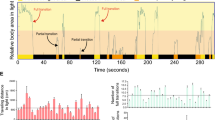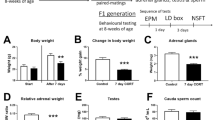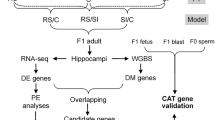Abstract
The influence of genetic factors on psychological traits and disorders has been repeatedly demonstrated; however, the molecular mechanisms underlying such an influence remain largely unknown. Anxiety-related disorders constitute the most common class of mental disorder in humans, with women being diagnosed far more frequently than men. A better understanding of the genetic and gender-related mechanisms mediating anxiety traits should enable the development of more rational methods for preventing and treating anxiety disorders. In this study we have aimed to identify, for the first time, quantitative trait loci (QTL) influencing anxiety/emotionality-related traits in rats. To this end, two strains—Lewis (LEW) and Spontaneously Hypertensive Rats (SHR)—that differ for several behavioral measures of anxiety/emotionality were intercrossed. A QTL analysis of the F2 population revealed suggestive loci for various traits, including behaviors in the elevated plus-maze and blood pressure. In addition, one major QTL explaining 50.4% of the total variance (LOD = 7.22) was identified on chromosome 4 for the locomotion in the central and aversive area of the open field. Two other relevant QTLs have been recently mapped near this chromosomic region in the rat, which also harbors Tac1r, the gene encoding for the substance P receptor. Our major QTL affected females but not males and its effect depended on the type of cross (LEW or SHR grandmothers). The present results reveal a complex genetic basis underlying emotional behaviors and they confirm the existence of interactions between genetic factors and sex for this kind of trait. Further investigation of the loci identified herein may give clues to the pathophysiology of psychiatric disorders such as anxiety-related ones.
This is a preview of subscription content, access via your institution
Access options
Subscribe to this journal
Receive 12 print issues and online access
$259.00 per year
only $21.58 per issue
Buy this article
- Purchase on Springer Link
- Instant access to full article PDF
Prices may be subject to local taxes which are calculated during checkout
Similar content being viewed by others
Author information
Authors and Affiliations
Corresponding author
Rights and permissions
About this article
Cite this article
Ramos, A., Moisan, MP., Chaouloff, F. et al. Identification of female-specific QTLs affecting an emotionality-related behavior in rats. Mol Psychiatry 4, 453–462 (1999). https://doi.org/10.1038/sj.mp.4000546
Received:
Revised:
Accepted:
Published:
Issue Date:
DOI: https://doi.org/10.1038/sj.mp.4000546
Keywords
This article is cited by
-
Genetic effects in a progressive model of parkinsonism induced by reserpine
Psychopharmacology (2023)
-
Effects of Repeated Treatment with Midazolam in SHR and SLA16 Rat Strains in the Triple Test
Behavior Genetics (2018)
-
The Quinpirole Hypolocomotive Effects are Strain and Route of Administration Dependent in SHR and SLA16 Isogenic Rats
Behavior Genetics (2017)
-
The clinical measurement, measurement method and experimental condition ontologies: expansion, improvements and new applications
Journal of Biomedical Semantics (2013)
-
Anxiety genetics – findings from cross-species genome-wide approaches
Biology of Mood & Anxiety Disorders (2013)



